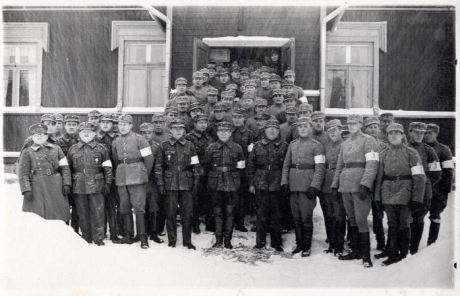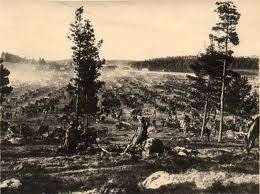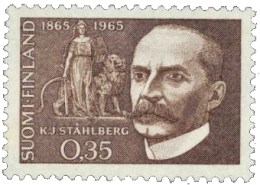5. Finland's Independence Movement
Independent Finland
The fall of the emperor in March 1917 (The February Revolution) and the establishment of a temporary government in Russia caused a power conflict in Finland. Social Democrats, the Agrarian Party, and other activists believed the Parliament was the highest authority. The right wing's argument was that Russia's temporary government had inherited the highest power from the Czar.
Six representatives from the right wing parties and six Social Democrats were elected to the new senate. In July 1917, the Social Democrats, who had the majority of the seats in Parliament, managed to pass a law determining that the highest authority in Finland was the Parliament. Russia's temporary government responded by disbanding the Parliament. The right wing parties won the majority of seats in the new elections.
In November 1917, Bolsheviks led by Lenin dethroned Russia's temporary government (October Revolution). The Social Democrats wanted to co-operate with the Bolshevik government, while the right wing wanted a rapid separation from Russia. The situation was tense. In order to support the demands of the working class, the Social Democratic Party arranged a general strike in November. It resulted in new laws, such as an eight-hour workday and general and equal voting rights in municipal elections.
The Parliament, in which the right wing parties had the majority, declared itself the highest authority in Finland on November 15, 1917. The majority of the new government, led by P.E. Svinhufvud, consisted of right wing party members. The declaration of independence was affirmed in Parliament on December 6, 1917. Finland sought recognition for its independence from foreign states, but the world was waiting for Russia's actions. Soviet-Russia recognized Finland on December 31, 1917.
The 1918 Civil War in Finland
In the early 20th century, social and political problems had developed to a critical state in Finland. The conditions of the working class and the rural poor were unacceptable. Reforms by the Parliament and Senate appeared to take far too long, making the working class doubt democracy. Rapid inflation, strikes, and unemployment increased their anger. In 1917, a poor supply of food caused famine in some regions.
Revolutionary ideas spread among the working class. Finns chose their sides, splitting into socialistic (Reds) and right wing (Whites) groups. During 1917, both sides formed armed-guard troops that had violent fights. Finland didn't have an army of its own, nor did it have operational police forces. 40,000 Russian soldiers were still based in the country, increasing the feeling of insecurity.

Guards of Whites consisted of land owners and the middle class.
In January 1918, the Senate declared that the White guards were the government's armed forces. The labor movement's committee mobilized the Red troops, ordering them to take over key administrative offices in Helsinki on January 27, 1918. The Senate fled to Vasa, where the newly appointed leader of the White troops, C.G.E. Mannerheim, was also located. Mannerheim and his troops disarmed 5,000 Russian soldiers.
A White government led by P.E. Svinhufvud was formed in Vasa. The Red government was based in Helsinki, led by Kullervo Manner. The Red government's objective was to introduce socialism to Finland and to empower the working class. The objective of the White government was to ensure that Finland remained independent.
Brief and Bloody Civil War
The Reds were primarily supported by the industrialized Southern Finland, whereas the Whites were supported by the farming region of Ostrobothnia. Independent farmers and the middle class were fighting for the Whites. Laborers living in towns and the rural poor fought for the Reds.
The main front was formed along the Pori-Tampere-Lahti-Viipuri axis. In February 1918, the Reds attacked towards the North, but failed. Svinhufvud turned to Germany for help. Germany accepted the request after it had secured favorable economical and military terms from Finland. In February 1918, about 1,000 Jaegers returned to Finland from Germany to fight for the Whites.
The key battle was fought in March, when the Whites conquered Tampere. The Red government fled to St Petersburg. In April, the Whites received reinforcements from Germany -- 10,000 men and naval forces. German troops disembarked at Hankoniemi and swiftly conquered Helsinki. The Whites arranged their victory parade about three months after the war had started, on May 16, 1918.
The total number of deceased during the war was about 40,000 people. Both sides conducted acts of terror. The losers of the war were mistreated. 80,000 Reds were assembled and placed in prison camps, where 12,000 died of diseases and hunger. Heavy punishments to losers increased bitterness against the Whites, straining relations until the 1930s.

After the civil war, the lost side was assembled in prison camps.
There are many different opinions of why the war broke out. The different ways that Finns of different backgrounds still view the traumatic war of 1918 is reflected in the names given to the conflict. The Whites called it a War of Freedom, while Reds called it a Class War. Both sides have also called it a Revolt. Some additional terms used are the Fraternal War and the Red Revolt.
The Fight for a Constitution
The bloody Civil War had interrupted the process of confirming Finland's republican constitution. The war turned a number of right wing politicians into monarchy supporters. They believed monarchy would be stronger and could prevent the kind of turbulence they had experienced.They felt a monarchy could also rise above conflicts between political parties.
The Finnish Party and the Swedish People's Party of Finland supported monarchy. The Young Finnish Party didn't have a single view. A republic was supported by the Social Democrats and the Agrarian Party, among others. Monarchy supporters managed to push through a monarchial constitution because the Social Democrat members of the Parliament had lost their seats due to the civil war.
German King
In October 1918, Prince Frederick Charles of Hesse, from Germany, was elected the King of Finland. Finland's close relationship with Germany strained foreign policy relationships further in November, when Germany surrendered, ending the First World War. Frederick Charles reassessed the situation, and gave up his crown. Mannerheim, who had opposed close German relations, was appointed the administrator of the Finnish state.
The republican constitution for Finland was ratified on July 17, 1919. K.J. Ståhlberg was elected the first president of Finland. Comprehensive prerogative powers were given to the president.

Finland's first president, K.J. Ståhlberg (1865 - 1952).